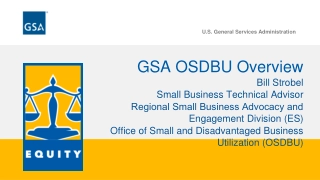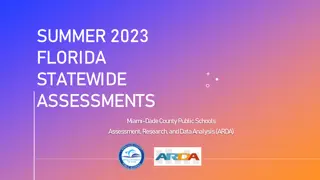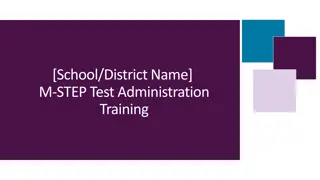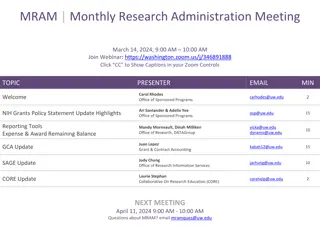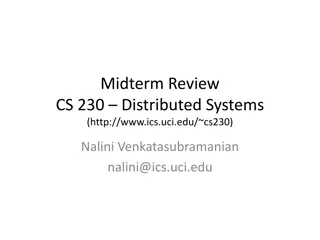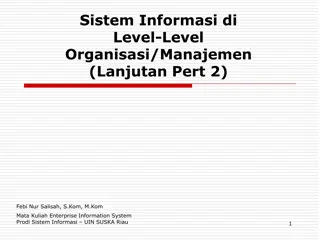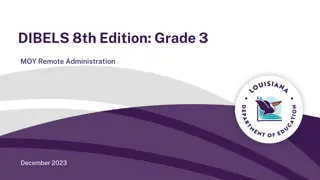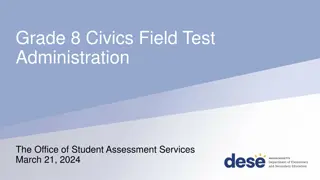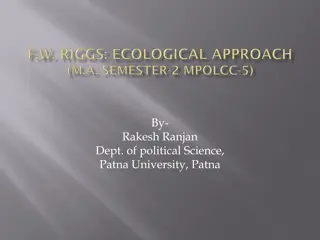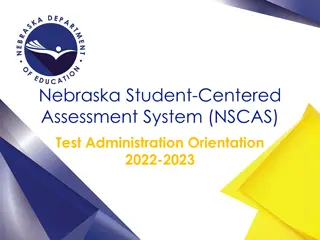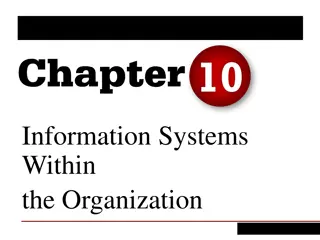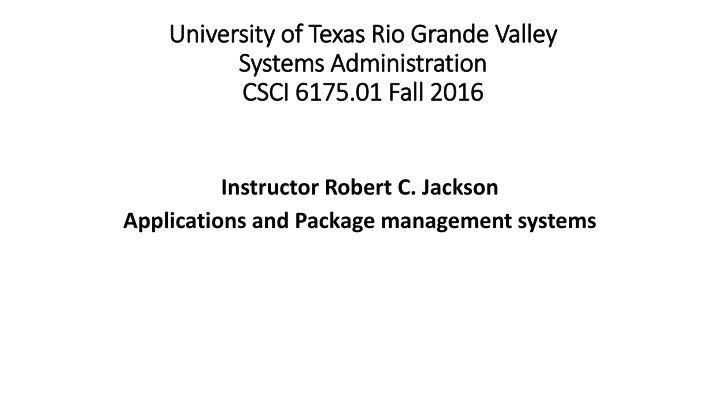
Applications and Package Management Systems Overview
Explore the role of applications and package management systems in maintaining a consistent state of operating systems. Dive into Windows Application Manager and Windows Package Management, including details on Windows Installer, creating Windows MSI packages, and more.
Download Presentation

Please find below an Image/Link to download the presentation.
The content on the website is provided AS IS for your information and personal use only. It may not be sold, licensed, or shared on other websites without obtaining consent from the author. If you encounter any issues during the download, it is possible that the publisher has removed the file from their server.
You are allowed to download the files provided on this website for personal or commercial use, subject to the condition that they are used lawfully. All files are the property of their respective owners.
The content on the website is provided AS IS for your information and personal use only. It may not be sold, licensed, or shared on other websites without obtaining consent from the author.
E N D
Presentation Transcript
University of Texas Rio Grande Valley University of Texas Rio Grande Valley Systems Administration Systems Administration CSCI 6175.01 Fall 2016 CSCI 6175.01 Fall 2016 Instructor Robert C. Jackson Applications and Package management systems
University of Texas Rio Grande Valley Systems Administration University of Texas Rio Grande Valley Systems Administration CSCI 6175.01 Fall 2016 CSCI 6175.01 Fall 2016 Applications and Package management systems Application and Package management also known as software management is a collection of tools involved with application and software installation, removal, upgrades, package formats and repositories, such that the OS is maintained in a consistent state. These managers deal with distributions, metadata, dependencies, archives and checksums. Package managers usually eliminate the need for manual installation of software. On the other hand source code applications need to be compiled and built manually. These applications must be manually synchronized with the systems application database, where applicable.
University of Texas Rio Grande Valley Systems Administration University of Texas Rio Grande Valley Systems Administration CSCI 6175.01 Fall 2016 CSCI 6175.01 Fall 2016 Applications and Package management systems Windows Application Manager: - Windows Installer is used for installation, maintenance and removal of windows applications. Installation files and information are packaged into installation packages, COM files and MSI (MS Installer) files. - Packages have a structure consisting of Products, features, components and Key Paths. - Package Setup consists of several phases, these are: User interface, execution, and rollback. - Windows Installer can advertise rather than install a package, install on demand, allow administrative installation, merge applications, interoperate with other Windows features, extract files and custom install. - installer packages can be created using Visual studio and must interact with pertinent DLL s and the registry.
University of Texas Rio Grande Valley University of Texas Rio Grande Valley Systems Administration Systems Administration CSCI 6175.01 Fall 2016 CSCI 6175.01 Fall 2016 Applications and Package management systems Windows Package management - creating a windows MSI package 1. Create project 2. Add files 3. Build and install 4. Remove installed file 5. Edit product and company names 6. Create shortcuts 7. Change product version - see: http://www.advancedinstaller.com/user-guide/tutorial- simple.html
University of Texas Rio Grande Valley University of Texas Rio Grande Valley Systems Administration Systems Administration CSCI 6175.01 Fall 2016 CSCI 6175.01 Fall 2016 Applications and Packagemanagement systems Windows Package management creating an application from source To write your program, you'll need: 1) The Java SE Development Kit 8 (JDK 8) You can download the Windows version now. (Make sure you download the JDK, not the JRE.) Consult the installation instructions. 2) A text editor (notepad will do) 3) Create a source file /** * The HelloWorldAppclass implements an application that * simply prints "Hello World!" to standard output. */ class HelloWorldApp{ public static void main(String[] args) { System.out.println("Hello World!"); // Display the string. } } 4) Save file as HelloWorldApp.txt, with encoding as ANSI. 5) Compile the source file into a .class file In a CMD window type: javac HelloWorldApp.java 6) Run compiled java application In CMD window type: java -cp . HelloWorldApp
University of Texas Rio Grande Valley University of Texas Rio Grande Valley Systems Administration Systems Administration CSCI 6175.01 Fall 2016 CSCI 6175.01 Fall 2016 Applications and Package management systems Linux Application Management - for RHEL use yum, rpm or manual tools, to install, upgrade and remove applications. The following is a list of the most commonly-used yum commands. For a complete list of available yum commands, refer to man yum. - yum install <package name/s> - yum update <package name/s> - yum check-update - yum remove <package name/s> - yum provides <file name> - yum search <keyword> - yum localinstall <absolute path to package name/s> By default, yum is configured through /etc/yum.conf
University of Texas Rio Grande Valley University of Texas Rio Grande Valley Systems Administration Systems Administration CSCI 6175.01 Fall 2016 CSCI 6175.01 Fall 2016 Applications and Package management systems Linux Application Management Sample /etc/yum/conf [main] cachedir=/var/cache/yum keepcache=0 debuglevel=2 logfile=/var/log/yum.log pkgpolicy=newest distroverpkg=redhat-release tolerant=1 exactarch=1 obsoletes=1 gpgcheck=1 plugins=1 metadata_expire=1800 [myrepo] name=RHEL 5 $releasever - $basearch baseurl=http://local/path/to/yum/repository/ enabled=1
University of Texas Rio Grande Valley University of Texas Rio Grande Valley Systems Administration Systems Administration CSCI 6175.01 Fall 2016 CSCI 6175.01 Fall 2016 Applications and Package management systems Linux Application Management Sample /etc/yum/conf The [repository] section of the /etc/yum.conf file contains information about a repository yum can use to find packages during package installation, updating and dependency resolution. A repository entry takes the following form: [repository ID] name=repository name baseurl=url, file or ftp://path to repository
University of Texas Rio Grande Valley University of Texas Rio Grande Valley Systems Administration Systems Administration CSCI 6175.01 Fall 2016 CSCI 6175.01 Fall 2016 Applications and Package management systems Linux Application Management Using rpm (RPM Package Manager) refer to man rpm for information: install a RPM package rpm -ivh foo-1.0-2.i386.rpm uninstall a RPM package rpm e some_package upgrade a RPM package rpm Uvh foo-2.2.3-x86_64.rpm Query a package rpm q foo Display package information rpm qi foo List files in a package rpm ql foo Check dependencies of a package rpm -qpR BitTorrent-5.2.2-1-Python2.4.noarch.rpm - See http://www.tecmint.com/20-practical-examples-of-rpm-commands-in-linux/ for more examples.
University of Texas Rio Grande Valley University of Texas Rio Grande Valley Systems Administration Systems Administration CSCI 6175.01 Fall 2016 CSCI 6175.01 Fall 2016 Applications and Package management systems Linux Application Management Red Hat Manual Package Management get package - wget <link to tar.gz file> Unzip tar.gz file - tar zxvf <*.tar.gz file> Cd to directory where source is (where the configure script is locate). READ the INSTALL or README file. Get configure help - configure help | less Configure build environment, and generate Makefile. - ./configure Compile source distribution - make Install executables - make install
University of Texas Rio Grande Valley University of Texas Rio Grande Valley Systems Administration Systems Administration CSCI 6175.01 Fall 2016 CSCI 6175.01 Fall 2016 Applications and Package management systems Linux Application Management for Ubuntu and debian use apt (Advanced Package Tool), dpkg, or manual tools. How to fetch updates - apt update upgrade all packages currently installed on the system - apt upgrade list packages that can be upgraded on the system - apt list upgradeable install a new package - apt install <package_name> Remove a package apt remove <package_name> remove both package and config files - apt purge <package_name> Search packages - apt search <package_name> Find info about packages - apt show <package_name> List all packages - apt list
University of Texas Rio Grande Valley University of Texas Rio Grande Valley Systems Administration Systems Administration CSCI 6175.01 Fall 2016 CSCI 6175.01 Fall 2016 Applications and Package management systems Linux Application Management for Ubuntu and debian use apt (Advanced Package Tool), dpkg (debian package manager), or manual tools. List packages - dpkg l dpkg l | grep apache list apache webserver List specific package - dpkg L apache2 Determine which package installed a file of executable - dpkg S /etc/host Install a debian package - dpkg -i flashpluginnonfree_2.8.2+squeeze1_i386.deb Remove a debian package - dpkg -r flashpluginnonfree
University of Texas Rio Grande Valley University of Texas Rio Grande Valley Systems Administration Systems Administration CSCI 6175.01 Fall 2016 CSCI 6175.01 Fall 2016 Applications and Package management systems Linux Package management Ubuntu and Debian manual package management get package - wget <link to tar.gz file> Unzip tar.gz file - tar zxvf <*.tar.gz file> Cd to directory where source is (where the configure script is locate). READ the INSTALL or README file. Get configure help - configure help | less Configure build environment, and generate Makefile. - ./configure Compile source distribution - make Install executables - make install
University of Texas Rio Grande Valley Systems Administration University of Texas Rio Grande Valley Systems Administration CSCI 6175.01 Fall 2016 CSCI 6175.01 Fall 2016 Q&A



